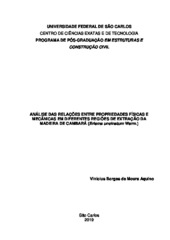| dc.contributor.author | Aquino, Vinicius Borges de Moura | |
| dc.date.accessioned | 2019-03-18T13:00:31Z | |
| dc.date.available | 2019-03-18T13:00:31Z | |
| dc.date.issued | 2019-03-15 | |
| dc.identifier.citation | AQUINO, Vinicius Borges de Moura. Análise das relações entre propriedades físicas e mecânicas em diferentes regiões de extração da madeira de Cambará (Erisma Uncinatum Warm). 2019. Dissertação (Mestrado em Engenharia Civil) – Universidade Federal de São Carlos, São Carlos, 2019. Disponível em: https://repositorio.ufscar.br/handle/ufscar/11088. | * |
| dc.identifier.uri | https://repositorio.ufscar.br/handle/ufscar/11088 | |
| dc.description.abstract | This research had the purpose of evaluating the relationship between the physical and mechanical properties of Cambará wood extracted from three distinct sites: Vera, Mucajaí and south of Rondônia. The possibility of estimating (linear regression, exponential, geometric and logarithmic models) the physical and mechanical properties as a function of apparent density will also be evaluated. This research was motivated by the fact that there is no consideration in the normative code the influence of the extraction regions on the physical and mechanical properties of timber, since different climatic conditions, vegetation and soil in which the tree can influence their growth and, consequently, the values of its physical and mechanical properties. The ABNT NBR 7190, the Kruskal-Wallis variance analysis and the resampling technique were considered in the accomplishment of the procedures. The results of ANOVA indicated an equivalence index equal to 100% for the properties of the Vera region, 94% for the regions of Mucajaí and South of Rondônia. The resampling technique led to similar results for the Vera and Mucajaí regions and for the southern region of Rondônia, the equivalence index was equal to 89%. The results of the ANOVA to estimate the physical and mechanical properties in function of the apparent density indicated that it was not possible to make such estimates for Cambará wood. | eng |
| dc.description.sponsorship | Não recebi financiamento | por |
| dc.language.iso | por | por |
| dc.publisher | Universidade Federal de São Carlos | por |
| dc.rights.uri | Acesso aberto | por |
| dc.subject | Madeira de Cambará | por |
| dc.subject | Propriedades físicas e mecânicas | por |
| dc.subject | Análise de Variância | por |
| dc.subject | Resistência à compressão | por |
| dc.subject | Densidade aparente | por |
| dc.subject | Cambará wood | eng |
| dc.subject | Physical and mechanical properties | eng |
| dc.subject | Analysis of Variance (ANOVA) | eng |
| dc.subject | Compression strength | eng |
| dc.subject | Apparent density | eng |
| dc.title | Análise das relações entre propriedades físicas e mecânicas em diferentes regiões de extração da madeira de Cambará (Erisma Uncinatum Warm) | por |
| dc.title.alternative | Analysis of relations between physical and mechanical properties in different harvest regions of Cambará wood (Erisma Uncinatum Warm) | eng |
| dc.type | Dissertação | por |
| dc.contributor.advisor1 | Christoforo, André Luis | |
| dc.contributor.advisor1Lattes | http://lattes.cnpq.br/7623383075429186 | por |
| dc.description.resumo | Esta pesquisa teve a finalidade de avaliar de relação existente entre as propriedades físicas e mecânicas da madeira de Cambará extraída de três locais distintos: Vera, Mucajaí e sul de Rondônia. Também será avaliado a possibilidade de se estimar (modelos de regressão linear, exponencial, geométrico e logarítmico) as propriedades físicas e mecânicas em função da densidade aparente. Tal pesquisa foi motivada por não haver no dispositivo normativo nenhuma consideração acerca da influência das regiões de extração nas propriedades físicas e mecânicas das madeiras, uma vez que diferentes condições climáticas, vegetação e solo na qual a árvore medra podem influenciar seu crescimento e, por consequência, os valores de suas propriedades. Considerou-se na realização dos procedimentos a ABNT NBR 7190, a análise de variância de Kruskal-Wallis e a técnica de reamostragem. Os resultados da ANOVA indicaram índice de equivalência igual a 100% para as propriedades da região de Vera, 94% para as regiões de Mucajaí e Sul de Rondônia. A técnica de reamostragem levou a resultados semelhantes para as regiões de Vera e Mucajaí e para a região Sul de Rondônia, o índice de equivalência foi igual a 89%. Os resultados da ANOVA para estimativa de propriedades físicas e mecânicas em função da densidade aparente indicaram que não foi possível fazer tais estimativas para a madeira de Cambará. | por |
| dc.publisher.initials | UFSCar | por |
| dc.publisher.program | Programa de Pós-Graduação em Engenharia Civil - PPGECiv | por |
| dc.subject.cnpq | ENGENHARIAS::ENGENHARIA CIVIL::CONSTRUCAO CIVIL::MATERIAIS E COMPONENTES DE CONSTRUCAO | por |
| dc.subject.cnpq | ENGENHARIAS::ENGENHARIA CIVIL::CONSTRUCAO CIVIL | por |
| dc.subject.cnpq | ENGENHARIAS::ENGENHARIA CIVIL::ESTRUTURAS | por |
| dc.subject.cnpq | ENGENHARIAS::ENGENHARIA CIVIL | por |
| dc.subject.cnpq | ENGENHARIAS::ENGENHARIA CIVIL::ESTRUTURAS::ESTRUTURAS DE MADEIRAS | por |
| dc.ufscar.embargo | Online | por |
| dc.publisher.address | Câmpus São Carlos | por |
| dc.contributor.authorlattes | http://lattes.cnpq.br/5303314880493623 | por |
